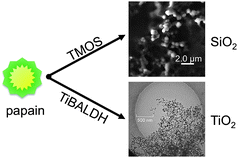Non-specific proteases can produce metal oxidenanoparticles
Abstract
Biomineralization-based techniques have emerged as alternatives to traditional materials syntheses as they offer ambient fabrication conditions with a high degree of compositional specificity. This highlight focuses on a paper in the current issue of the Journal of Materials Chemistry by Feldheim and colleagues that demonstrates the extrapolation of metal


 Please wait while we load your content...
Please wait while we load your content...